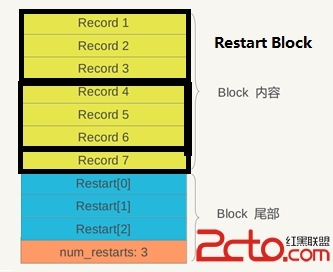您好,登錄后才能下訂單哦!
您好,登錄后才能下訂單哦!
如何理解LevelDB源碼中的SSTable,很多新手對此不是很清楚,為了幫助大家解決這個難題,下面小編將為大家詳細講解,有這方面需求的人可以來學習下,希望你能有所收獲。
MemTable是內存表,而當內存表增長到一定程度時(memtable.size> Options::write_buffer_size),會將當前的MemTable數據持久化(LevelDB中實際有兩份MemTable,后面LevelDB數據庫備忘時會講)。持久化的文件(sst文件)稱之為Table,LevelDB中的Table分為不同的層級,當前版本的***層級為7(0-6),table中level0的數據***,level6的數據最舊。
Compaction動作負責觸發內存表到SSTable的轉換,LOG恢復時也會執行,這里不關心Compaction或恢復的任何細節,后面會單獨備忘。
LevelDB通過BuildTable方法完成SSTable的構建,其創建SSTable文件并將memtable中的記錄依次寫入文件。BuildTable帶了一個輸出參數,FileMetaData:
1 struct FileMetaData { 2 int refs; 3 int allowed_seeks; // Seeks allowed until compaction 4 uint64_t number; 5 uint64_t file_size; // File size in bytes 6 InternalKey smallest; // Smallest internal key served by table 7 InternalKey largest; // Largest internal key served by table 8 9 FileMetaData() : refs(0), allowed_seeks(1 << 30), file_size(0) { }number為一個遞增的序號,用于創建文件名,allowed_seeks作者有提到,是當前文件在Compaction到下一級之前允許Seek的次數,這個次數和文件大小相關,文件越大,Compaction之前允許Seek的次數越多,這個Version備忘時也會提。
BuildTable方法中真正做事的時TableBuilder,通過調用Add方法將所有記錄添加到數據表中,完成SSTable創建。
TableBuilder主要做了如下幾件事:
創建Index Block:用于Data Block的快速定位
將數據分為一個個的Data Block
如文件需要壓縮,執行壓縮動作
依次寫入Data Block、Meta Block、Index Block、Footer Block,形成完整的SSTable文件結構
其中階段1-3由Add方法完成,階段4由Finish方法完成,先來看Add方法:
1 void TableBuilder::Add(const Slice& key, const Slice& value) { 2 Rep* r = rep_; 3 assert(!r->closed); 4 if (!ok()) return; 5 if (r->num_entries > 0) { 6 assert(r->options.comparator->Compare(key, Slice(r->last_key)) > 0); 7 } 8 9 //Index Block:Data Block的索引元數據。 10 if (r->pending_index_entry) { 11 assert(r->data_block.empty()); 12 r->options.comparator->FindShortestSeparator(&r->last_key, key); 13 std::string handle_encoding; 14 r->pending_handle.EncodeTo(&handle_encoding); 15 r->index_block.Add(r->last_key, Slice(handle_encoding)); 16 r->pending_index_entry = false; 17 } 18 19 r->last_key.assign(key.data(), key.size()); 20 r->num_entries++; 21 r->data_block.Add(key, value); 22 23 const size_t estimated_block_size = r->data_block.CurrentSizeEstimate(); 24 if (estimated_block_size >= r->options.block_size) { 25 Flush(); //超過單數據塊大小,寫入文件。 26 } 27 }Add方法創建Data Block、IndexBlock,DataBlcok通過Flush刷入磁盤文件。
再來看Finish方法:
1 Status TableBuilder::Finish() { 2 //Data Block 3 Rep* r = rep_; 4 Flush(); 5 6 assert(!r->closed); 7 r->closed = true; 8 9 //Meta Block 10 BlockHandle metaindex_block_handle; 11 BlockHandle index_block_handle; 12 if (ok()) 13 { 14 BlockBuilder meta_index_block(&r->options); 15 // TODO(postrelease): Add stats and other meta blocks 16 WriteBlock(&meta_index_block, &metaindex_block_handle); 17 } 18 19 //Index Block 20 if (ok()) { 21 if (r->pending_index_entry) { 22 r->options.comparator->FindShortSuccessor(&r->last_key); 23 std::string handle_encoding; 24 r->pending_handle.EncodeTo(&handle_encoding); 25 r->index_block.Add(r->last_key, Slice(handle_encoding)); 26 r->pending_index_entry = false; 27 } 28 WriteBlock(&r->index_block, &index_block_handle); 29 } 30 31 //Footer 32 if (ok()) 33 { 34 Footer footer; 35 footer.set_metaindex_handle(metaindex_block_handle); // 36 footer.set_index_handle(index_block_handle); 37 std::string footer_encoding; 38 footer.EncodeTo(&footer_encoding); 39 r->status = r->file->Append(footer_encoding); 40 if (r->status.ok()) { 41 r->offset += footer_encoding.size(); 42 } 43 } 44 return r->status; 45 }Finish依次寫入:尚未寫入的***一塊Data Block及Meta Block、Index Block、Footer。Meta Block暫未使用,Footer則保存了meta block、index block的位置信息。
Block
Data Block、Meta Block、Index Block是業務劃分,分別代表用戶數據塊、元數據塊及用戶數據索引塊。其存儲格式均為Block結構:

Record代表一條數據,藍色及紅色部分(統一稱作”重啟點”)為附加信息,而這些是做什么的呢?兩點:性能優化、節省空間。
我們先來看Restart列表的構建邏輯:
1 void BlockBuilder::Add(const Slice& key, const Slice& value) { 2 Slice last_key_piece(last_key_); 3 ...... 4 size_t shared = 0; 5 if (counter_ < options_->block_restart_interval) { 6 // See how much sharing to do with previous string 7 const size_t min_length = std::min(last_key_piece.size(), key.size()); 8 while ((shared < min_length) && (last_key_piece[shared] == key[shared])) { 9 shared++; 10 } 11 } 12 else { //restart時保存完整的key值 13 // Restart compression 14 restarts_.push_back(buffer_.size()); 15 counter_ = 0; 16 } 17 const size_t non_shared = key.size() - shared; 18 19 //Record信息 20 // shared size | no shared size | value size | no shared key data | value data 21 // Add "<shared><non_shared><value_size>" to buffer_ 22 PutVarint32(&buffer_, shared); 23 PutVarint32(&buffer_, non_shared); 24 PutVarint32(&buffer_, value.size()); 25 // Add string delta to buffer_ followed by value 26 buffer_.append(key.data() + shared, non_shared); 27 buffer_.append(value.data(), value.size()); 28 29 // Update state 30 last_key_.resize(shared); 31 last_key_.append(key.data() + shared, non_shared); 32 assert(Slice(last_key_) == key); 33 counter_++; 34 }每隔一定間隔(block_restart_interval)Record就會創建一個新的重啟點,重啟點內容為當前block的大小,即重啟點在block內的偏移。
每當添加一個新的重啟點時,重啟點指向位置的Record中一定保存了完整的key值(shared size = 0),隨后的Record中保存的key值僅為和上一個Record的差異值。因為Key在Block中是有序排列的,所以相鄰key值重疊區域節省的空間還是非常可觀的。
基于上述實現,問題來了:當需要定位一條記錄時,因為record中key的信息是不完整的,僅包含了和上一條的差異項,但上一條記錄本身也只包含了和再上一條的差異項,那么定位一條記錄時如何做key比較?如果需要一直向上查找完成key值拼接,性能上會不會有損傷?
分析這個問題就要了解重啟點的定位:Block的一級索引,SSTable的二級索引(Index Block是SSTable的一級索引)。本文將每個重啟點記錄位置所屬的Record列表稱為一個Restart Block
假設每條record記錄的都是完整的key值時,從SSTable中查找一條記錄的工作流如下:
根據Key值從Index Block中找到所屬的Data Block
根據Key值從“重啟點”列表中找到所屬的Restart Block,從Restart Block的起始位置進行key值比較,找到正確的記錄。
在上述流程中,我們必定會先找到一個Restart Point,隨后進行key值比較,而Restart Point記錄本身包含了完整的key值信息,后續key值均可基于此key得到。
Restart列表本身做為索引,提升了查找性能,而key值存儲的小技巧又降低了空間使用率,在不損傷性能的情況小降低空間利用率,這是一個很好的例子。
即使這樣,作者覺得還不夠,空間利用率還可以進一步優化,并且不損傷任何讀取數據的性能。
做法和Restart列表的做法類似,是在Index Block中,通過調用FindShortestSeparator / FindShortSuccessor方法實現。
1 // If *start < limit, changes *start to a short string in [start,limit). 2 // Simple comparator implementations may return with *start unchanged, 3 // i.e., an implementation of this method that does nothing is correct. 4 virtual void FindShortestSeparator(std::string* start, const Slice& limit) const = 0; 5 6 // Changes *key to a short string >= *key. 7 // Simple comparator implementations may return with *key unchanged, 8 // i.e., an implementation of this method that does nothing is correct. 9 virtual void FindShortSuccessor(std::string* key) const = 0;
FindShortestSeparator找到start、limit之間最短的key值,如“helloworld”和”hellozoomer”之間最短的key值可以是”hellox”。FindShortSuccessor則更極端,用于找到比key值大的最小key,如傳入“helloworld”,返回的key值可能是“i”而已。
看完上述內容是否對您有幫助呢?如果還想對相關知識有進一步的了解或閱讀更多相關文章,請關注億速云行業資訊頻道,感謝您對億速云的支持。
免責聲明:本站發布的內容(圖片、視頻和文字)以原創、轉載和分享為主,文章觀點不代表本網站立場,如果涉及侵權請聯系站長郵箱:is@yisu.com進行舉報,并提供相關證據,一經查實,將立刻刪除涉嫌侵權內容。